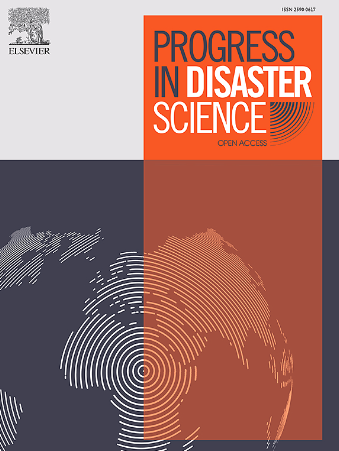Assessing regional resilience of different land use types during snowstorms using mobile data
IF 3.8
Q3 ENVIRONMENTAL SCIENCES
引用次数: 0
Abstract
Understanding the resilience of areas with different land-use types can enhance a city's ability to respond to and recover from disasters. Based on Docomo mobile GPS data and the 2018 Fukui Prefecture snow disaster, this study explores the resilience of areas with different land-use types from the grid level. First, the resilience triangle method was employed to assess the robustness, vulnerability, and survivability of different land-use types at the 500-m grid level. Second, Pearson correlation analysis and causal inference determined that snow depth is a causal factor leading to changes in grid resilience, thereby identifying the optimal time points for each grid to distinguish between disaster end and recovery start. Finally, a resilience map of Fukui Prefecture was created, integrating road data to identify cities with poor resilience and road sections prone to congestion during snow disasters. The results indicate that land-use types such as factories, agricultural land, building land, and mid-high-rise buildings have better resilience, especially mid-high-rise buildings, which exhibit strong resistance and recovery ability when facing disturbances, allowing them to return to normal states quickly. In urban planning, prioritizing such resilient building types could be beneficial. In contrast, sparse low-rise buildings, parks, facility land, and dense low-rise buildings exhibit poorer resilience and take longer to recover. Additionally, areas with poor traffic resilience in Fukui Prefecture are mainly concentrated in the northern part, particularly the vertical sections in Fukui City, Awara City, and Sakai City, as well as the vertical section from Sabae City to Echizen City and the horizontal section from Eiheiji-cho to Katsuyama City.
利用移动数据评估不同土地利用类型在暴风雪期间的区域恢复能力
了解不同土地利用类型地区的恢复能力可以提高城市应对灾害和从灾害中恢复的能力。基于Docomo移动GPS数据和2018年福井县雪灾,从网格层面探讨不同土地利用类型地区的恢复力。首先,采用弹性三角法对500 m栅格水平上不同土地利用类型的稳健性、脆弱性和生存性进行了评价。其次,Pearson相关分析和因果推理确定雪深是导致电网恢复力变化的一个因果因素,从而确定每个电网区分灾难结束和恢复开始的最佳时间点。最后,创建了福井县的复原力地图,整合道路数据,识别复原力差的城市和雪灾期间容易拥堵的路段。结果表明,工厂用地、农用地、建筑用地和中高层建筑等土地利用类型具有较好的恢复能力,尤其是中高层建筑在面对干扰时表现出较强的抵抗能力和恢复能力,能够快速恢复到正常状态。在城市规划中,优先考虑这种具有弹性的建筑类型可能是有益的。相比之下,稀疏的低层建筑、公园、设施用地和密集的低层建筑的恢复能力较差,恢复时间较长。此外,福井县交通弹性较差的区域主要集中在北部,特别是福井市、原市、酒井市的垂直区域,以及从Sabae市到Echizen市的垂直区域和从eiheijicho到Katsuyama市的水平区域。
本文章由计算机程序翻译,如有差异,请以英文原文为准。
求助全文
约1分钟内获得全文
求助全文
来源期刊

Progress in Disaster Science
Social Sciences-Safety Research
CiteScore
14.60
自引率
3.20%
发文量
51
审稿时长
12 weeks
期刊介绍:
Progress in Disaster Science is a Gold Open Access journal focusing on integrating research and policy in disaster research, and publishes original research papers and invited viewpoint articles on disaster risk reduction; response; emergency management and recovery.
A key part of the Journal's Publication output will see key experts invited to assess and comment on the current trends in disaster research, as well as highlight key papers.
 求助内容:
求助内容: 应助结果提醒方式:
应助结果提醒方式:


